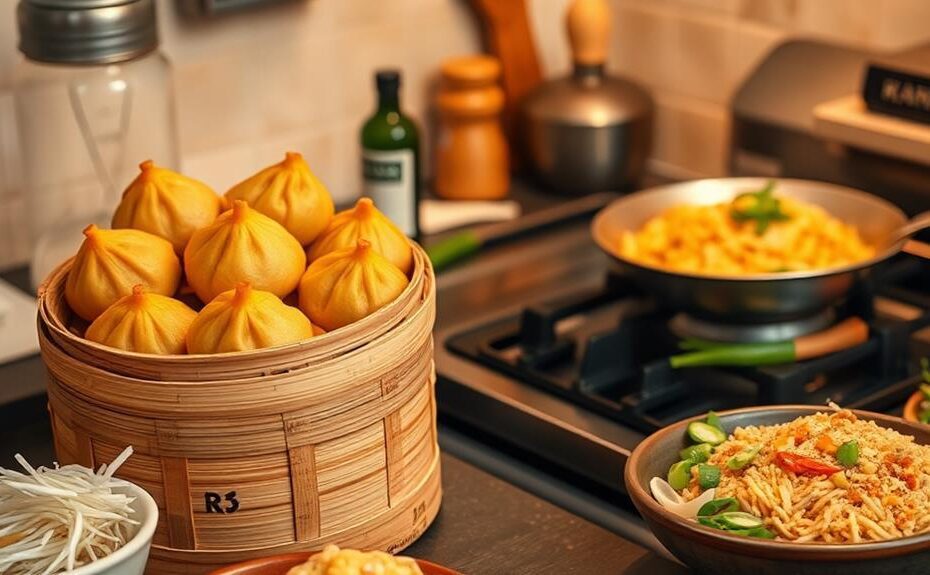Mastering Lumpia Fillings
To create delicious and authentic Filipino-style lumpia, start by perfecting your filling mixture. Combine ground pork, chopped veggies, and seasonings in a balanced ratio to achieve the ideal flavor and texture.
Refrigerate the mixture to allow the flavors to meld together before assembling the lumpia.
Perfecting the Rolling Technique
To achieve the perfect roll, use the right amount of filling and fold the lumpia wrapper correctly.
Seal the edges with a mixture of water and flour or a beaten egg to prevent the filling from spilling out during cooking.
Choosing the Cooking Method
Decide on the cooking method that suits your taste and nutrition goals.
Fry lumpia at 350°F for a crispy exterior, or opt for baking or air-frying for a healthier alternative.
Experiment with different cooking methods to find your favorite way to prepare lumpia and pancit.
Elevating Your Lumpia and Pancit Game
As you experiment with flavors, nutrition, and organization, you'll discover new secrets to take your lumpia and pancit to the next level.
Continuously refine your techniques and try new ingredients to elevate your cooking skills and impress your family and friends.
Mastering Lumpia Fillings
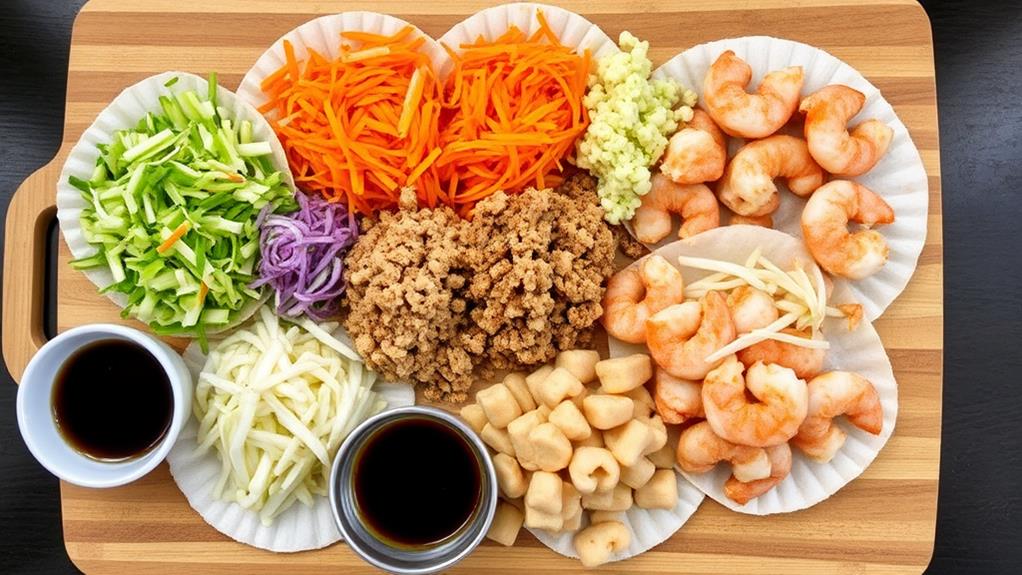
Crafting the Perfect Lumpia Filling
To create a well-balanced lumpia filling, combine ground pork with finely chopped vegetables like carrots, onions, and cabbage. This mixture provides a harmonious blend of tender meat and crunchy vegetables.
Add seasonings like garlic, soy sauce, and black pepper to enhance the overall taste profile of the filling.
Vegetarian Option
For a vegetarian version, substitute ground pork with sautéed mushrooms, carrots, and cabbage. To maintain crispiness, cook high-water-content vegetables first.
Filling Portion and Refrigeration
Use 1.5 to 2 tablespoons of filling per wrapper to prevent tearing and ensure adequate filling.
Refrigerate the filling mixture for at least an hour to allow flavors to meld and improve the binding of ingredients.
Perfecting the Rolling Technique
Mastering the Rolling Technique
To achieve golden brown and crispy lumpia, perfecting the rolling technique is crucial.
Step 1: Prepare the Wrapper
Lay a lumpia wrapper in a diamond orientation, with the pointed end facing you, for easier rolling and sealing.
Step 2: Add the Right Amount of Filling
Use 1.5 to 2 tablespoons of filling to avoid overstuffing, which can cause tearing during the rolling process.
Step 3: Fold and Roll
Fold the bottom corner of the wrapper over the filling, tuck in the sides, and roll tightly to secure the filling inside.
Apply consistent pressure to maintain even thickness and avoid gaps that could lead to breakage.
Sealing the Edges
Use a mixture of water and flour or a beaten egg to seal the edges and ensure they don't open during frying.
With practice, you'll be able to roll lumpia like a pro and cook them to perfection on medium heat.
Essential Cooking Methods
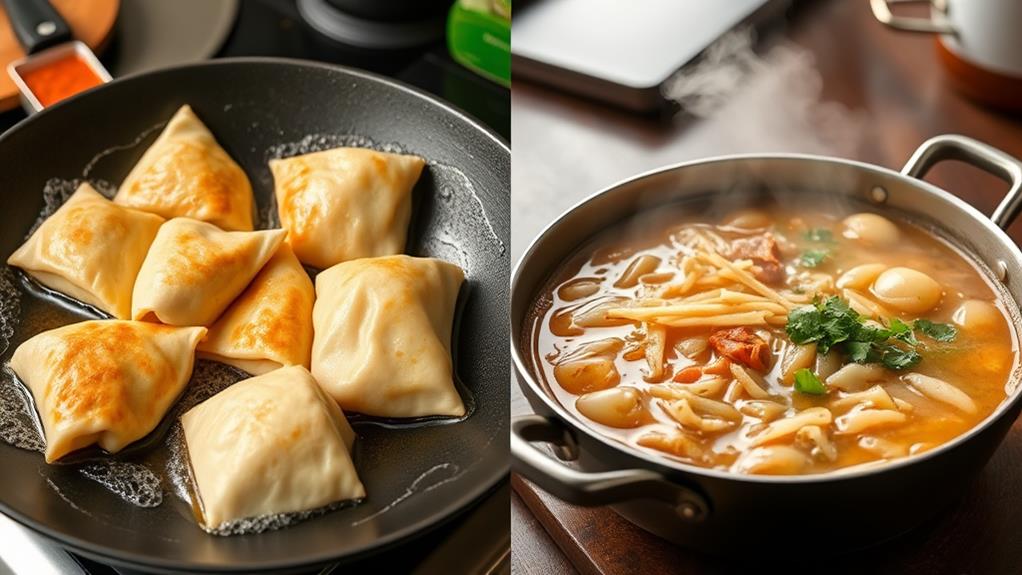
Accurate Oil Temperature is Crucial for Frying Lumpia
When frying lumpia, the oil temperature must be 350°F to achieve a golden brown texture.
To ensure even cooking, fry in small batches of 4-6 and avoid overcrowding the pot.
For a healthier alternative, bake at 375°F or air fry at 400°F to achieve a crispy texture without sacrificing flavor.
Proper Cooking of Noodles Enhances Flavor in Pancit
To cook pancit noodles, use reserved chicken stock to enhance the overall flavor of the dish.
Cook the noodles until they're tender.
Tips for Making Lumpia Filling and Wrapping
When making the lumpia filling, sauté high-water-content vegetables first to maintain their crispiness and prevent sogginess in the final product.
When wrapping, lay the wrapper in a diamond orientation and fill with 1.5 to 2 tablespoons of filling to avoid tearing.
Balancing Flavors and Nutrition
Balancing Flavors and Nutrition in Lumpia and Pancit
When preparing lumpia and pancit, it is crucial to strike a balance between flavors and nutrition to create dishes that are both delicious and healthy.
Using Seasonings Effectively
To achieve this balance, use a combination of seasonings like garlic, soy sauce, and sesame oil to enhance the flavor of your lumpia and pancit without overpowering the natural ingredients.
This approach allows you to add depth to your dishes without sacrificing nutritional value.
Incorporating Nutritious Ingredients
Incorporate high-water-content vegetables like cabbage and carrots into your lumpia filling to add freshness and balance out the richness of the meat.
This technique not only adds flavor but also increases the nutrient density of your dish.
Air-Frying for a Healthier Option
Opt for air-frying your lumpia instead of deep-frying to reduce oil retention and calorie count, achieving a crispy exterior without sacrificing nutrition.
This method allows you to enjoy the crispy texture of fried lumpia while keeping your dish healthy and nutritious.
Organizing Your Cooking Station
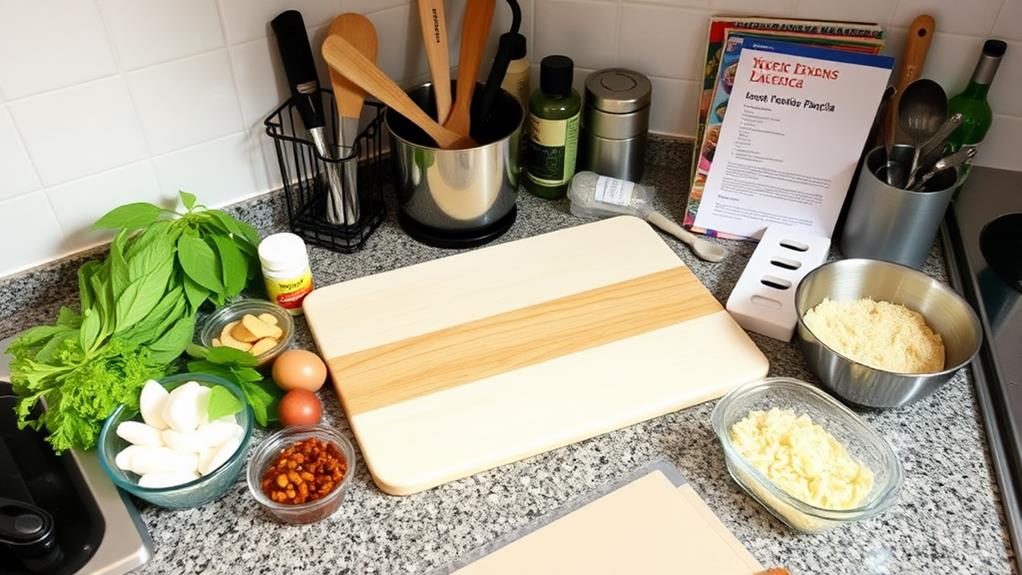
Efficient Cooking Station Setup
To cook lumpia and pancit effectively, a well-organized cooking station is essential. A clean and spacious workspace is necessary to accommodate all ingredients and cooking utensils. This can be achieved by using a large cutting board and mixing bowls.
Organize Ingredients by Category
Grouping ingredients into categories such as proteins, vegetables, and sauces streamlines the cooking process. This helps to quickly locate specific ingredients and prevents confusion.
Prepare for Lumpia Wrapping
Keep a sealing mixture, like an egg wash, and a parchment-lined baking sheet nearby to easily seal and store wrapped lumpia before frying.
Arrange Cooking Utensils
Place cooking utensils, including a frying pan, spatula, and measuring cups, within arm's reach to minimize movement and maintain efficiency while cooking.
Designate a Frying or Baking Area
Set up a specific area for frying or baking lumpia, ensuring that oil or cooking sprays are accessible and surfaces are clear of clutter. This prevents accidents and allows for smooth cooking.
Common Mistakes to Avoid
Beyond a well-organized cooking station, avoiding common mistakes is crucial when cooking lumpia and pancit at home. Careless mistakes can sabotage your efforts, so it's essential to be mindful of potential pitfalls.
Overfilling lumpia wrappers can cause them to tear and spill their filling during frying. To avoid this, leave enough space at the top of the wrapper to allow for easy folding and sealing.
Frying spring rolls in oil that's not hot enough results in a soggy mess. Use a thermometer to ensure the oil reaches the ideal temperature of 350°F.
Insufficient refrigeration of the filling mixture affects the texture and flavor of your Filipino Lumpia. Refrigerate the mixture long enough to allow the flavors to meld together.
Seal the lumpia closed securely with egg wash or water to prevent them from opening during frying.
When cooking pancit, avoid overcooking the noodles; they should be cooked just until tender to maintain their desired texture.
Let them cool slightly before serving to prevent mushiness.
What are the Best Tips for Cooking Lumpia and Pancit at Home Using Essential Ingredients?
For delicious lumpia and pancit at home, use essential lumpia and pancit ingredients like garlic, onions, carrots, cabbage, and soy sauce. Ensure the right balance of flavors by sautéing the vegetables and adding the soy sauce for an authentic taste. Experiment with different meat fillings for the lumpia for a variety of flavors.
Creative Variations and Twists
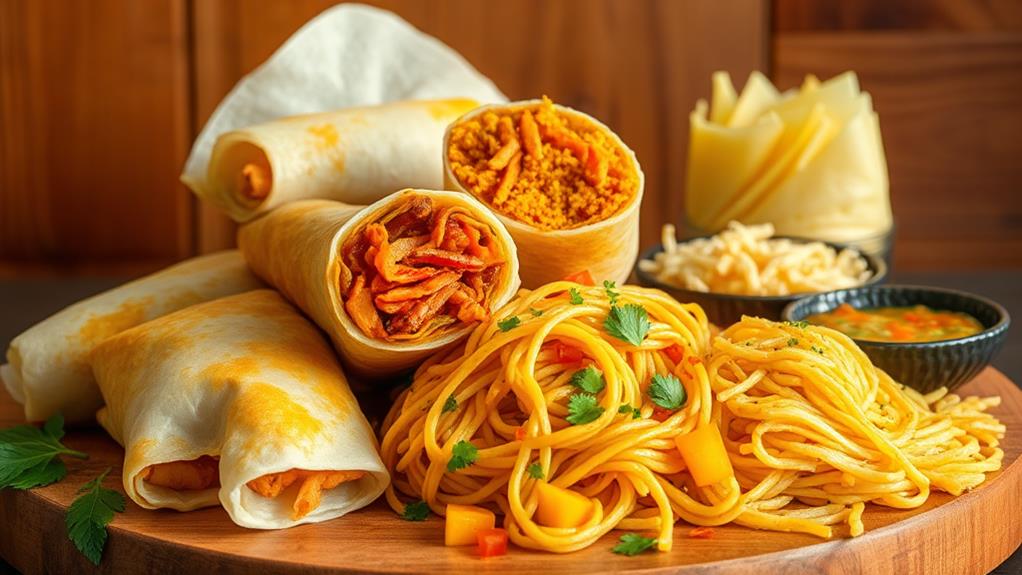
Experimenting with Lumpia and Pancit Recipes
Protein Variations
You can substitute ground pork with chicken, beef, or shrimp to create different protein-based lumpia fillings.
For a vegetarian option, use tofu and mixed vegetables as a healthier alternative.
Adding Fresh Flavors
Incorporate herbs like cilantro or basil into the filling mixture for added freshness.
You can also add unique ingredients like cheese or spicy sausage to create a fusion-style lumpia.
Dessert Lumpia
Fill wrappers with sweetened fruits, chocolate, or cream cheese and fry or bake them for a sweet surprise.
Pancit Variations
Mix in unconventional vegetables like bell peppers or zucchini to add variety to your pancit dish.
You can also use different noodles like rice noodles or whole grain options for added nutrition.
Creative Dipping Sauces
Try a sweet and sour sauce or a tangy peanut sauce to elevate your dish to the next level.
Frequently Asked Questions
How Do You Fry Lumpia and Keep It Crispy?
To achieve crispy lumpia, heat the oil to 350°F (175°C). This temperature ensures a crunchy texture.
Fry in small batches to prevent overcrowding, which can make the lumpia soggy.
Cook for 4-6 minutes, or until they're golden brown, then drain on paper towels. This step is crucial to remove excess oil and maintain crispiness.
Serve hot with a side of dipping sauce on a serving platter to enjoy the best flavor and texture.
Store leftovers in an airtight container to preserve the crispy lumpia wrappers and flavorful filling. This will help maintain the crunchiness even after storage.
How Long Should I Cook Lumpia?
Frying Temperature: 350°F is the ideal temperature for frying lumpia, resulting in a crispy exterior and a deliciously cooked filling.
Cooking Time: The cooking time for lumpia depends on whether they're fresh or frozen.
Fresh lumpia take 4 minutes to cook, while frozen ones need around 6 minutes.
Is It Better to Cook Lumpia Frozen or Thawed?
Cooking lumpia from frozen is the better option. This is because frozen lumpia maintain their crispy exterior and moist interior when cooked.
In contrast, thawing lumpia can lead to sogginess. For example, cooking frozen lumpia at 350°F for 6 minutes results in a golden brown color without excess oil absorption.
How Do You Know When Lumpia Is Done Frying?
When is lumpia done frying?
Lumpia is done frying when it turns a golden brown color. This typically takes around 4-6 minutes, depending on whether it's fresh or frozen.
To confirm, check the texture by lifting one out of the frying oil with a slotted spoon.
If the wrapper is crispy and the filling is hot, it's ready to serve.
